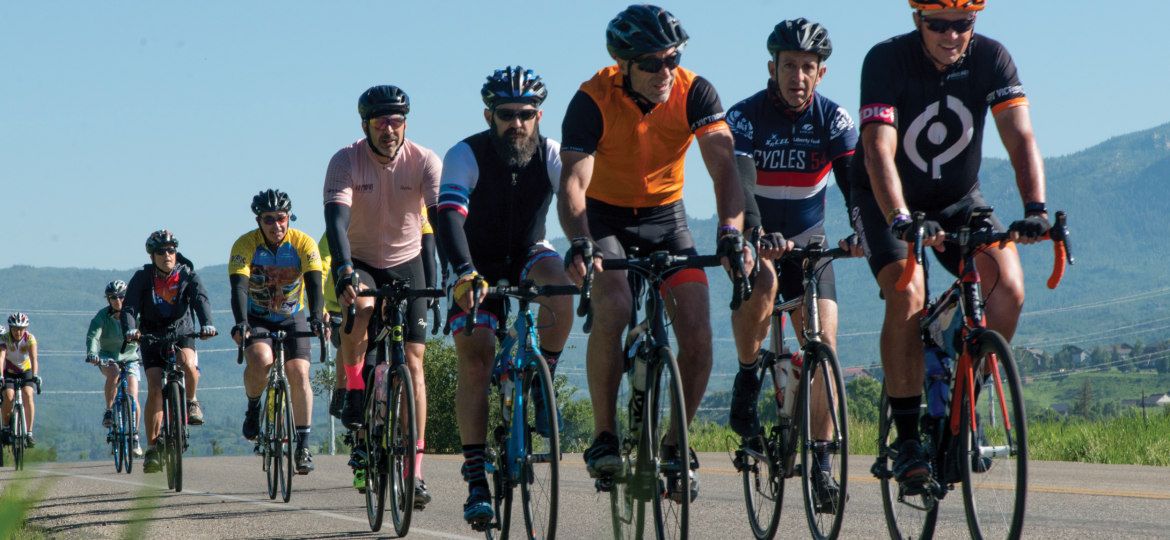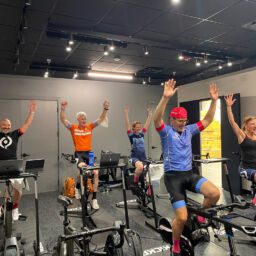"Exercise needs to move from a recommendation to a prescription for people with Parkinson's."
Dr. Jay Alberts, Department of Biomedical Engineering, Cleveland Clinic
Since 2003, Dr. Jay Alberts has been researching how to exercise with Parkinson's and the role that cycling has on reducing the symptoms of Parkinson’s. It all began when he rode a tandem bike across Iowa (RAGBRAI) with a person with Parkinson’s.
In this episode, you will learn:
- About the ride that started it all
- What forced exercise and high-intensity exercise are and why those types of exercise help reduce Parkinson’s symptoms
- A surprising symptom that seems to improve with exercise
- The best exercise you can do and why
- About Pedaling for Parkinson’s and how he’s bringing cycling classes to gyms and studios all over the country to help people live well with Parkinson’s
Notes
- Dr. Alberts first discovered how beneficial cycling is when he rode tandem with a person with Parkinson's. After the ride, her handwriting improved dramatically.
- Further testing with a person who had DBS resulted in similar benefits. When his stimulator was turned off, his tremor re-emerged. Then they went on a 50 miles bike ride. Twelve miles into the ride, his tremor was gone. At the end of the ride, he was asymptomatic.
- Dr. Alberts discovered the importance of forced exercise (tandem) and high-intensity exercise in alleviating Parkinson's symptoms
- Tandem riding is considered forced exercise as the person with Parkinson's is pedaling at a faster rate than they normally would - closer to 80-90rpm vs 30-40 rpm
- His research has shown that those who do forced exercise perform better on manual/dexterity tasks afterward
- Even though you do not necessarily use your hands while riding, there is a change in brain function which leads to better dexterity
- It's not exactly clear what is happening, but the effects of forced exercise have to do with the quantity of information being generated and the quality of information being sent back to the brain
- Improvement in smell has also been found to improve after exercise
- No one exercise is a panacea - the key is choosing something that will increase quantity and quality of information to the brain such as cycling, boxing or dancing—activities that require timing, coordination, speed, etc.
- Pedaling for Parkinson's is now in 34 states. Dr. Alberts wants to know if they can extrapolate what they learn in the lab to community-based programs and get similar results
As with every therapy you try to treat your Parkinson's symptoms, be sure to consult with your doctor, movement disorder specialist, neurologist and everyone on your care team. Anecdotal evidence is great; however, not every exercise works the same for everyone. Do your due diligence and make sure all of your experimentation is under the direct and frequent supervision of your doctors.
Concepts Mentioned in this Podcast & Further Reading
- Exercise is Medicine for the Brain
- High-Intensity Exercise Helps Slow the Progression of Parkinson's
- How a Bicycle Ride Led to Ground-Breaking Parkinson's Research
- Community-Based Cycling Class for Slowing Disease Progression
- Brain Training: Effects of Aerobic Exercise in Parkinson's Disease
- The Effect of Forced-Exercise Therapy for Parkinson's Disease on Motor Cortex Functional Connectivity
- Pedaling for Parkinson's
- Cognitive and psychological effects of outdoor cycling finds equal results for normal bikes and e-bikes.

Dr. Jay Alberts is the Biomedical Engineer & Vice Chair of Clinical Transformation, Director of the Cleveland Clinic Concussion Center. He's a Principal Investigator within the Functional Electrical Stimulation Center of Excellence at the Louis Stokes VA Medical Center. And he also holds an appointment in the Department of Biomedical Engineering at Case Western Reserve University. Prior to joining the Cleveland Clinic, Dr. Alberts was an Assistant Professor in the Department of Applied Physiology at Georgia Institute of Technology.
Thanks for Listening!
To share your thoughts:
- Leave a note in the comment section below.
- Ask a question by emailing us here.
- Share this show on Facebook.
To help out the show:
- Leave an honest review on iTunes. Your ratings and reviews really help, and we read each one.
- Subscribe on iTunes.



















GREAT podcast series…learned so much from listening to all of them. Please do another season!
Thank you for listening, Peter. We’re definitely discussing the possibility of a second season, and we’ll keep everyone posted.
Are there continuing studies of cycling effect on PD to try to link explanation for cause and effect. I have been cycling for 35+ years (0ver 100 K miles Had PD for close to seven. Now age 70, slowing down how do I keep it going?
Regards,
Larry Cohen
Hi Larry – Thank you for visiting our blog. If you have not yet read these posts on our site, this would be a good place to start:
https://www.davisphinneyfoundation.org/video/effects-of-forced-exercise-on-parkinsons/
https://www.davisphinneyfoundation.org/blog/exercise-is-medicine-for-the-brain/
https://www.davisphinneyfoundation.org/blog/pushing-the-pedal-on-research/
https://www.davisphinneyfoundation.org/blog/bicycle-ride-led-to-parkinsons-research/
And to get info on current research we’re funding on this topic, this may be most helpful: https://www.davisphinneyfoundation.org/research/community-based-cycling-class-for-slowing-disease-progression/
I have a mountain bike that I want to use for forced exercise. Are there any known add electronic/mechanism to create this function? I have a garmon watch with a limited heart rate ability. Can HR be a guide? any other ideas? Thanks Jon
Hi Jon – Forced exercise typically means that you are pedaling at a rate that is about 30% faster than you normally would. The goal would be about 80 rpm, which is usually much higher than people with Parkinson’s would do on their own. This article does a good job of describing it: https://www.bicycling.com/news/g20011415/-16. But please check with your doctors first before you attempt increasing your output and intensity as they will know what will be best for you at this point.
Help. When I tried to ride a bicycle I fell off. Can you suggest a bike that I could ride?Would a trike be better and give the same results?
Hi Anne, thank you for reaching out. We’re sorry to hear that you fell when you were riding. It’s best to discuss questions like this with a member of your care team, like your primary care physician or a physical therapist. However, some members of our community have had success with tricycles or recumbent bikes, like Catrikes here: https://www.catrike.com.